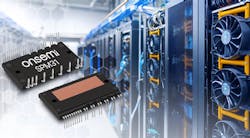SiC Delivers High-Density Power for Cooling Fans in Data Centers
Silicon carbide (SiC) is taking over the three-phase traction inverters in electric vehicles, which convert DC from the battery into AC used to control the motor. But thanks to its ability to handle higher voltages with improved thermal dissipation and faster switching frequencies, SiC is also a fit for the three-phase inverters in more compact electric motors. These include electronically commutated (EC) cooling fans in data centers, which are burning through more power to run AI training and inferencing—and producing more heat in the process.
onsemi rolled out its first generation of SiC-based intelligent power modules (IPMs) to bring higher power density and efficiency to these cooling fans compared to IGBTs. The 1,200-V modules, based on its "M3" SiC MOSFETs, are specifically designed to reduce losses in hard-switching situations and increase the short-circuit withstand time (SCWT). The IPMs are also highly integrated, including gate drivers used to control the SiC MOSFETs in the SPM 31 package. They can handle from 50 W to 10 kW of power.
The new family of EliteSiC IPMs span several current ratings from 40 to 70 A. These are complemented by the company’s line of intelligent power modules based on IGBTs, which cover current ratings of 15 to 35 A. onsemi revealed the new power modules at the Applied Power Electronics Conference (APEC) in Atlanta, Georgia.
Cooling Fans: Essential for Modern Data Centers
Today, technology giants and startups are constructing huge and increasingly power-hungry data centers to stay ahead in the AI race. And, as a result, the demand for EC cooling fans is increasing rapidly, said onsemi.
>>Check out our coverage of APEC 2025, as well as the TechXchange for similar articles and videos
High-performance AI chips are gulping down large amounts of power to handle training and inferencing. The Blackwell GPUs at the heart of NVIDIA's latest Al accelerators burn through as much as 1,200 W at peak loads.
Such AI chips drive the power requirements in data centers to over 100 kW per rack, up from the current range of 15 to 30 kW. However, delivering power around the data center involves many stages of power electronics that convert and condition it all, which can add up to significant power losses and, therefore, heat.
The situation requires smaller and more efficient cooling technologies, specifically liquid cooling, as traditional air cooling alone can’t mitigate the heat produced. While cooling fans are now widely used to maintain the optimal operating conditions in data centers, they tend to be large and power-hungry.
These days, cooling accounts for approximately 40% of the power required to run a data center. That’s only going to grow as the demands of AI push power-per-rack requirements to more than 200 kW in the future.
By replacing the IGBTs with SiC MOSFETs, onsemi said it can bring higher power density, efficiency, and reliability to these cooling fans while reducing the costs and complexity at a system level. For instance, integrating SiC IPMs in the power inverter could curtail the power and cost per cooling fan by more than 50% compared to IGBT-based IPMs with power losses of 500 W when operating at a 70% load current, said onsemi.
Highly Integrated, Yet Flexible, IPM
The six power switches inside the SiC-based IPM are arranged in a three-phase bridge. Power inverters have several legs, each responsible for controlling the current flow in one of the AC output phases. Each phase has an upper switch and a lower switch. The new IPM has separate source connections for the lower legs, said onsemi, giving customers more flexibility in choosing control algorithms. The faster switching of the SiC MOSFETs increases power density by reducing the magnetics and other passives in the system.
The new IPMs are also highly integrated, including the independent high-side gate-driver IC to control the SiC MOSFETs and other control ICs for protection features. Undervoltage protection, for example, prevents damage to the device when the voltage is low.
The IPMs also have a temperature sensor—specifically, a thermistor—inside the package to monitor the thermal situation. Other built-in components include the bootstrap diodes and resistors as well as internal boost diodes to increase the drive voltage to the high-side gate driver.
One of the core innovations in the SiC-based IPM is the use of more advanced direct bond copper (DBC) substrates, which have a very low thermal resistance that aids in thermal performance and heat dissipation.
>>Check out our coverage of APEC 2025, as well as the TechXchange for similar articles and videos
About the Author
James Morra
Senior Editor
James Morra is the senior editor for Electronic Design, covering the semiconductor industry and new technology trends, with a focus on power electronics and power management. He also reports on the business behind electrical engineering, including the electronics supply chain. He joined Electronic Design in 2015 and is based in Chicago, Illinois.



